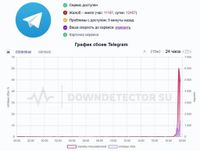On April 17, 2025, Telegram experienced a significant outage that impacted users across multiple countries, including Russia, Ukraine, and various European nations. Users reported a range of issues with the messaging app, leading to widespread frustration and confusion.
According to reports from DownDetector and other monitoring services, the troubles began around 19:15 Moscow time, with complaints flooding in from users struggling to connect to the app. Many users noted that the application failed to load on both mobile devices and computers, while others faced difficulties in sending messages, loading media content, and receiving notifications.
The Russian communications watchdog, Roskomnadzor, indicated that preliminary investigations suggest the outage is linked to infrastructure problems within the service itself. This assertion aligns with the experiences of users who reported that the app was completely unresponsive at times. Complaints were particularly pronounced in regions such as Uzbekistan, Crimea, and Moscow, alongside reports from countries like Germany, Bulgaria, and Spain.
"The app simply doesn’t load for me," shared one frustrated user from Moscow, echoing the sentiments of many experiencing similar issues. Data from DownDetector revealed that a staggering 56% of complaints originated from users of the mobile application, while 29% reported connection problems to the servers, and 7% faced challenges accessing the web version of Telegram.
In Ukraine, users reported similar problems, with many unable to open the application or send messages. The app's functionality appeared to deteriorate significantly, with some users experiencing delays of up to 10-15 minutes in message delivery. "I can’t send anything, and it feels like the app is just dead," lamented a user from Kyiv.
In addition to connectivity issues, some users noted that switching their IP address temporarily resolved the problems, suggesting that the outages might be linked to specific network configurations. However, this workaround was not a viable solution for everyone, leading to increased frustration.
Reports from various regions indicated that the problems were not limited to just one area; users from the Urals, Upper Volga, and other parts of Russia also reported significant disruptions. Complaints from the Orenburg region had been less frequent, but the overall sentiment indicated a growing dissatisfaction with the app’s reliability.
As the hours passed, the volume of complaints continued to rise, with users expressing their concerns on social media platforms. The frustration was palpable, as many relied on Telegram for both personal and professional communication. In a world where instant messaging is essential, such outages can have serious implications.
Despite the growing outcry, Telegram has yet to issue an official statement addressing the issues. The lack of communication has only fueled user anger, as many feel left in the dark regarding the status of the app and the expected resolution timeline.
This is not the first significant outage Telegram has faced in recent months. Users have reported various issues over the last six months, raising questions about the platform's infrastructure and reliability. As the digital landscape evolves, consistent performance is crucial for maintaining user trust and satisfaction.
The impact of this outage extends beyond just inconvenience; it highlights the reliance on digital communication tools in today’s fast-paced world. As businesses, educators, and individuals increasingly turn to platforms like Telegram for their daily interactions, the stakes are higher than ever for service providers to ensure their platforms are robust and dependable.
As users continue to navigate the challenges posed by this outage, many are left wondering about the future of messaging applications and their ability to handle widespread demand without faltering. The hope is that Telegram can resolve these issues swiftly and restore normalcy for its users, but for now, the frustrations continue to mount.









